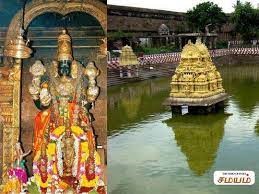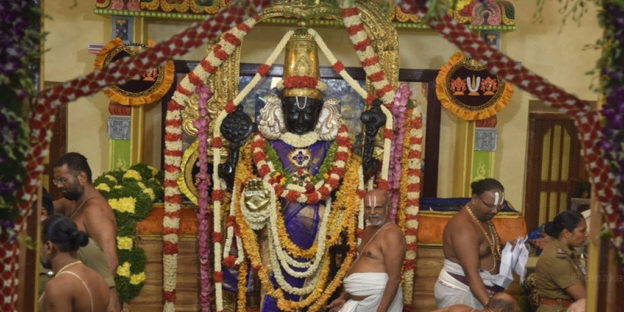
Kanchipuram is considered to be the Banaras (Varanasi / Kashi) of South India. Of the 108 divya desams, fourteen are inside Kanchipuram area. The Garuda purana enumerates seven most sacred places which bestow liberation (Moksha Puri) are Ayodhya, Mathura, Maya (Mayapuri or Haridwar), Kashi (Varanasi), Kanchi (Kanchipuram), Avantika (Ujjain) and Dwaravati (Dwaraka). These seven cities are giver of Moksha (Liberation) and are called Mokshapuri.
अयोध्या मथुरा माया काशी काञ्ची अवन्तिका ।
पुरी द्वारावती चैव सप्तैते मोक्षदायकाः ॥
Lord Sri Chaitanya Mahaprabhu visited Kanchipuram during his tour of South India and he spent two days in Kanchipuram. It is 75km from Chennai, 130km from Tirupati and 32km from Sriperumbudur (birthplace of Sripad Ramanujacarya).
Kanchipuram city is divided into two parts: the Little Kanchi (or Vishnu Kanchi) surrounding by Sri Varadaraja Perumal Temple, and the Big Kanchi (or Siva Kanchi) surrounding Sri Ekambaranathar Temple. Kanchipuram is also prominently known for silk industry. Sri Chaitanya-Charitamrita Madhya lila 9.68-70 mentions: Arriving at Siva-kanchi, Chaitanya Mahaprabhu visited the deity of Lord Siva. By His influence, He converted all the devotees of Lord Siva into Vaishnavas. The Lord then visited a holy place known as Vishnu-kanchi. There He saw Laksmi-Narayana deities, and He offered His respects and many prayers to please Them. Vishnu-kanchi is situated about five miles away from Kanchipuram. Lord Varadaraja, another form of Lord Vishnu, resides here. There is also a big lake known as Ananta-sarovara. When Sri Chaitanya Mahaprabhu stayed at Vishnu-kanchi for two days, He danced and performed kirtana in ecstasy. When all the people saw Him, they became devotees of Lord Krishna.
Original Story:
One very prominent story that runs practically across all the temples of Kanchipuram. Practically all the temples in Kanchipuram have sprung from one single story. One will find the reason of the existence of these temples, its greatness and beauty of this holy city.
This story is from the beginning of Satya yuga.
Lord Brahma performed extreme penances to have a deity of Lord Narayana and wanted to worship with love and devotion. Pleased by Lord Brahma’s penances, Lord Narayana benedicted him that Lord will appear in the form of a holy place known as Naimisharanya. Brahmaji was happy that a holy place was manifested but he was still not satisfied because he wanted to see the personal form of the Lord. He continued his prayers and as he continued his prayers, the Lord next appeared in the form of water body (Sarovar/ Lake) named Pushkar. But Brahma felt that he wanted to actually experience the Lord in his personal form and continued praying.
This time Lord actually appeared and told him to perform thousand Ashwamedha yajnas to see the direct form of the Lord. Lord Brahma pleaded that thousand yajnas will take a lot of time. Please tell me a method which is much quicker to experience your personal form of the Lord. The Lord told him there is one way out. He said, “If you go to Holy Place of Kanchipuram and perform one Yajna, it is equivalent to performing thousand yajnas.
So, Lord Brahma decided that he will go to Kanchipuram and perform this yajna. Even today whatever spiritual practices is performed in Kanchipuram, one get thousand fold results.
So, Brahma wanted to go to Kanchipuram and perform this yajna and he invited his wife Saraswati to be a part of this historic Yajna. Somehow, he was not able to find Saraswati and invite her. Due to lack of time, Brahma began the Yajna. And as soon as the yajna began, many impediments came.
Interestingly, the first obstacle was created by his own wife, Saraswati. So, when Saraswati came to know that Brahma was performing Yajna without her, she was really upset. She wanted to destroy the Yajna by sending the first obstacle in the form of a massive river which was coming at full speed like a tsunami. It was about to blow the yajna. Lord Brahma desperately sought shelter of Lord Narayana. Lord Narayana appeared as Vega Sethu, a deity sleeping on Ananta-Sesa. He was like a dam that stopped the flow of the river, Veghavati river. Vega means speed and Sethu means dam. A dam which obstructs the speed of a river. The Lord lies down in front of raging river and thus the Yajna place was saved.
The next obstacle came in the form of demons.
The demons wanted to obstruct the Yajna of Lord Brahma. So, they created complete darkness and Brahma could see nothing around.
Now imagine you’re doing it, you’re trying to do something focused and its absolutely pitch dark.
How can someone perform yajna in complete darkness? Lord Brahma took shelter of the Lord, and the Lord appeared in another form, Deepak Prakash, and created wonderful light. In this particular form, Lord Vishnu appeared as light. The Brahman effulgence that comes out from the body of Vishnu. It actually came in assistance of Lord Brahma to help see things.
Then Brahma continued performing his Yajna.This time the demons sent a very ferocious beast named as Sharaba. Sharaba is a very interesting type of animal which is a combination of five animals. It has a bird form, an elephant, a lion, a human and a snake.
The demon sent the Sharaba to attack Lord Brahma’s Yajna. Lord Brahma took shelter of Lord Narayana. Lord Narayana appeared in a very amazing form which is known as Ashtabujha (eight-armed form) and defeated the Sharaba animal and protected the yajna of Lord Brahma.
As Brahma continued performing his yajna, this time the demons came down to harrass Lord Brahma. They actually started troubling Brahma physically, trying to torture him and trying to kill him. At that time the Lord Brahma again prayed to the Supreme Lord, and this time, Narayana appeared as Lord Narasimha there. The Lord jumped at the demons and they all got scared and ran away.
When the Lord saw that all the demons ran away, He sat down in front of the Yajna kunda in a yogic posture, and therefore he became celebrated as the yoga Narasimha. Brahma continued performing yajna with pure devotion intensely for the appearance of the Supreme Lord. Then from within the Yajna kunda, appeared a beautiful (Vimaan) airplane. Especially when he appears through the fire yajnas, he appears in his Viman Airplane.
Once the yajna was completed, this beautiful vimana arose from the yajna kunda and a beautiful four handed deity of Lord Vishnu in a very magnanimous and merciful form was present. The Deity was folding his hands in a posture to give blessings (Varada), and this particular form of the Lord is known as Varadaraj, the king of giver of blessings. It is this Varadaraja Swamy who is the predominating deity of Vishnu Kanchi.

Temples in and around Kanchipuram and the respective deities.
Important temples in Kanchipuram:
1. Sri Deepa Prakasar Perumal Temple (or Thiruthanka)
2. Sri Ashtabujam Perumal Temple (or Sri Aadhikesava)
3. Sri Azhagiya Singar Perumal Temple (or Thiru Velukkai)
4. Sri Varadaraja Perumal Temple (or Thiru Kanchi)
5. Sri Yatoktakari Temple (or Thiru Vekka)
6. Sri Ulagalantha Perumal Temple (or Thiru Ooragam) and Sri Thirukkaar Vaanar Temple (or Thirukkaar Vaanam)
7. Sri Vaikunda Perumal Temple (or Thiruparameshwara Vinnagaram)
8. Sri Pandava Dhootha Temple (or Thiru Paadagam)
9. Sri Pachai Vannar Temple and Sri Pavalai Vannar Temple (or Thiru Pavala Vannan)
10. Sri Ekambaranathar Temple and Sri Nilathingal Thundathan Perumal Temple
11. Sri Kamakshi Temple and Sri Aadhi Varaha Perumal Temple
12. Sri Vijayaraghava Perumal Temple (or Thiruputkuzhi)
Important temples around Kanchipuram:
1. Sri Koorathazhwan Temple at Kooram
2. Sriperumbudur (birthplace of Sripad Ramanujacarya, 32km from Kanchipuram)
3. Sri Veeraraghava Perumal Temple (or Tiruvallore)
4. Srinivasa Perumal Temple at Elanagar
5. Ramanujar Sannidhi at Sevilimedu
